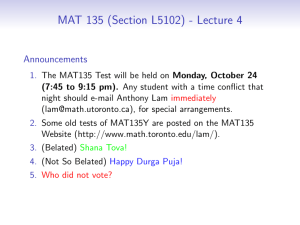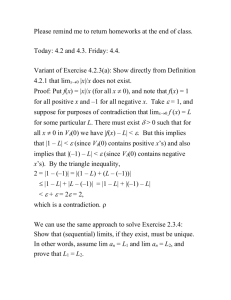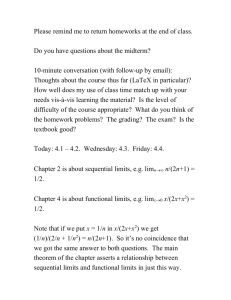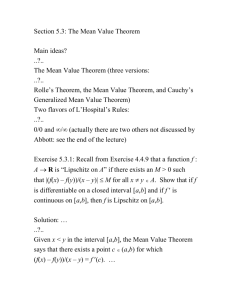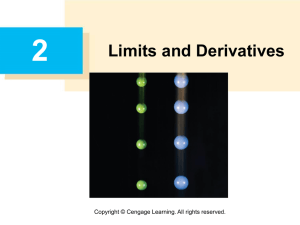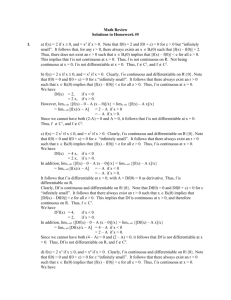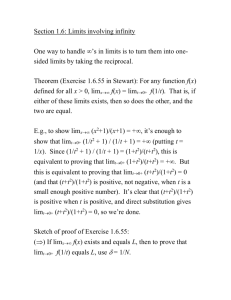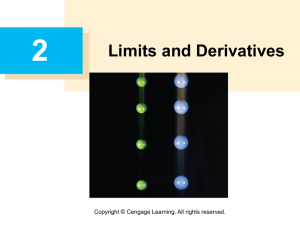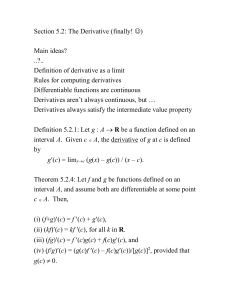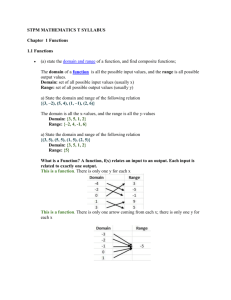laws governing limits.
advertisement
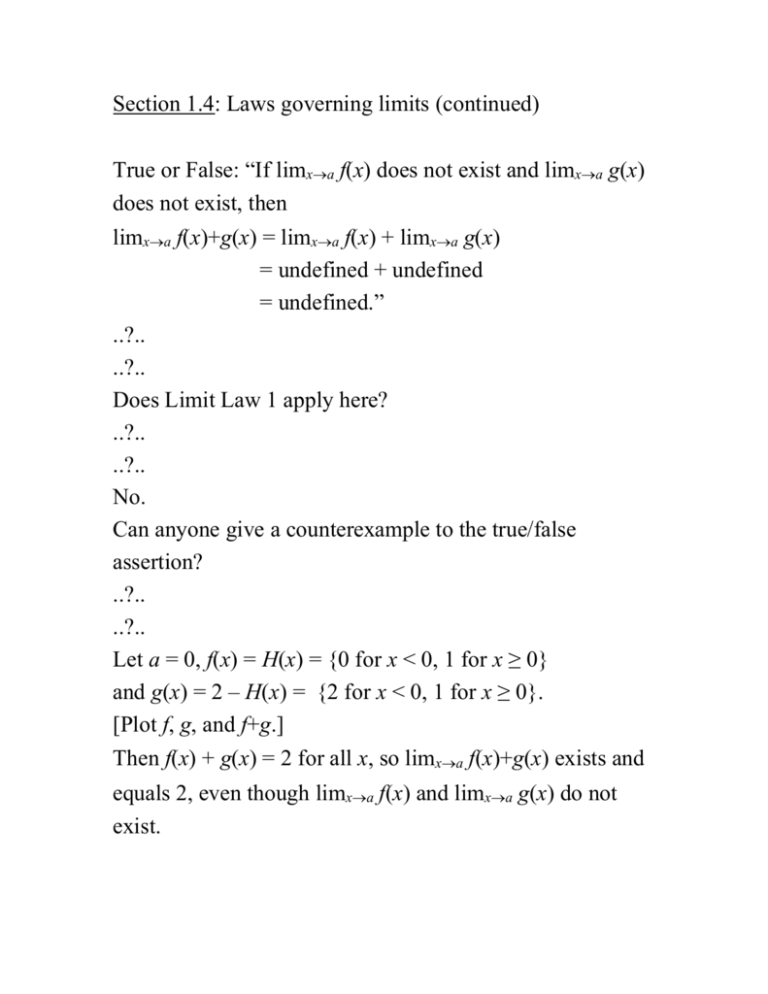
Section 1.4: Laws governing limits (continued)
True or False: “If limxa f(x) does not exist and limxa g(x)
does not exist, then
limxa f(x)+g(x) = limxa f(x) + limxa g(x)
= undefined + undefined
= undefined.”
..?..
..?..
Does Limit Law 1 apply here?
..?..
..?..
No.
Can anyone give a counterexample to the true/false
assertion?
..?..
..?..
Let a = 0, f(x) = H(x) = {0 for x < 0, 1 for x ≥ 0}
and g(x) = 2 – H(x) = {2 for x < 0, 1 for x ≥ 0}.
[Plot f, g, and f+g.]
Then f(x) + g(x) = 2 for all x, so limxa f(x)+g(x) exists and
equals 2, even though limxa f(x) and limxa g(x) do not
exist.
Or: Let a = 0, f(x) = H(x), g(x) = H(–x). [Plot f, g, and f+g.]
Note that in this case limxa f(x)+g(x) is 1 even though
f(a)+g(a) = 2.]
Or: Let a = 0, f(x) = 1/x, g(x) = –1/x. [Plot f, g, and f+g.]
Note that in this case limxa f(x)+g(x) is 0 even though
f(a)+g(a) is undefined.]
In each case limxa f(x) does not exist and limxa g(x) does
not exist but limxa f(x)+g(x) exists.
Don’t confuse “f(x) is undefined at x=0” with “limxa f(x)
does not exist”.
If limxa f(x) does not exist and/or limxa g(x) does not
exist, what does Limit Law 1 tell us?
..?..
..?..
Nothing!
Theorem: (the “locality principle”): If f(x) and g(x) agree
on some neighborhood of a (that is, if there exists 0 such
that f(x) = g(x) for all x satisfying 0 < |x – a| < 0) then
limxa f(x) = limxa g(x).
Example: To compute limx1 |x|, take f(x) = |x| and g(x) = x.
We have f(x) = g(x) for all x > 0, and in particular for all x
satisfying 0 < |x – 1| < 1/2; so, taking 0=1/2, we can apply
the preceding Theorem to conclude that limx1 |x| = limx1
f(x) = limx1 g(x) = limx1 x = 1. (Note: We could actually
get away with taking a larger 0; even 0=1 works.)
Can we use the locality principle to compute limx–1/3 |x|?
..?..
..?..
Yes; take f(x) = |x| and g(x) = –x. Set 0=1/3 and write
limx–1/3 |x| = limx–1/3 –x = 0
(the first step uses the locality principle, and the second
uses the direct substitution principle for polynomials).
Can we use the locality principle to compute limx0 |x|?
..?..
..?..
No; |x| isn’t equal to x throughout any open interval
centered on 0, nor is |x| equal to –x throughout any open
interval centered on 0.
In cases like this, we resort to computing a two-sided limit
by computing and comparing two one-sided limits:
limx0+ |x| = limx0+ x = 0 (since |x| = x for x > 0) and
limx0– |x| = limx0– –x = 0 (since |x| = –x for x < 0),
and since the two limits are equal we have limx0 |x| = 0.
Computing limits of piecewise-defined functions: If
{ L(x) for x < c,
f(x)
=
{ M for x = c,
{ R(x) for x > c,
[draw pictures] then:
If a < c, limxa f(x) = limxa L(x).
If a > c, limxa f(x) = limxa R(x).
As for the case a = c: limxc f(x) exists iff limxc– L(x) and
limxc+ R(x) exist and are equal, in which case limxc f(x)
equals their common value. (Note that M has no effect on
any of these limits!)
Theorem 3: If f(x) g(x) when x is near a (except possibly
at a) and limxa f(x) and limxa g(x) both exist, then
limxa f(x) limxa g(x).
If limxa f(x) is undefined and/or limxa g(x) is undefined,
what does Theorem 3 tell us?
..?..
..?..
Nothing!
Question for next time: Would Theorem 3 remain true if we
replaced “” by “<” in both places?
